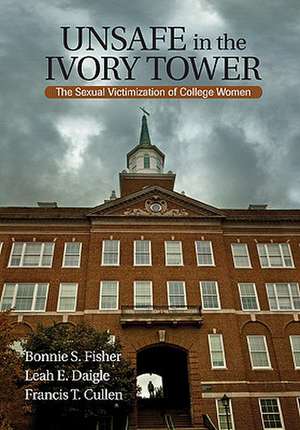Unsafe in the Ivory Tower: The Sexual Victimization of College Women
Autor Bonnie S. (Sue) Fisher, Leah E. Daigle, Francis T. Cullenen Limba Engleză Paperback – 21 dec 2009
| Toate formatele și edițiile | Preț | Express |
|---|---|---|
| Paperback (1) | 556.26 lei 6-8 săpt. | |
| SAGE Publications – 21 dec 2009 | 556.26 lei 6-8 săpt. | |
| Hardback (1) | 847.11 lei 6-8 săpt. | |
| SAGE Publications – 11 ian 2010 | 847.11 lei 6-8 săpt. |
Preț: 556.26 lei
Preț vechi: 654.42 lei
-15% Nou
106.45€ • 115.59$ • 89.42£
Carte tipărită la comandă
Livrare economică 23 aprilie-07 mai
Specificații
ISBN-10: 1412954770
Pagini: 248
Ilustrații: illustrations
Dimensiuni: 178 x 254 x 13 mm
Greutate: 0.43 kg
Ediția:New.
Editura: SAGE Publications
Colecția Sage Publications, Inc
Locul publicării:Thousand Oaks, United States
Recenzii
"Based on rigorous survey research that meets the highest scientific standards, this timely book challenges the notion that colleges are "ivory towers" or peaceful sanctuaries from the "real world." Fisher, Daigle, and Cullen make it completely clear that a substantial number of women on college campuses experience serious harms that would fit most states' definitions of felony rape or sexual assault. This book is mandatory reading for anyone seeking a rich, empirically informed understanding of one of society's most compelling social problems."
"Thought provoking....Some of the most comprehensive, evidence-based research on campus violence against women, with a refreshing look at potential strategies. With eye-opening, hard scientific data, this book answers most of the quintessential questions and will no doubt play a pivotal role in future research and prevention."
Unsafe in the Ivory Tower is truly a comprehensive overview and analysis of sexual victimization. It is theoretically grounded and provides an extensive and critical review of sexual victimization research, both within and beyond the ivory tower.
"While there is not a lack of books and articles available that discuss sexual victimization, this
particular text provides a valuable contribution to the literature as it focuses on an often ignored victim of this offense."
Cuprins
Beyond Real Rape
Sexual Victimization in Context
The Hidden Figure of Rape
Specially Designed Victimization Surveys
Koss’s Sexual Experiences Survey
One in Four: Publicizing the Rape Epidemic
Two Critiques
What’s Ahead
2. Beyond the Culture Wars: The Measurement of Sexual Victimization
The National Crime Victimization Survey
How the NCVS Measures Victimization
The First Step in Measuring Sexual Victimization: The NCVS Screen Questions
The Second Step in Measuring Sexual Victimization: The NCVS Incident Report
Measuring Sexual Victimization: The Next Generation
The National Women’s Study
The National Violence Against Women Survey
The National College Women’s Sexual Victimization Study
Revisiting the Koss-Gilbert Debate
Comparing Two Studies
Conclusion
3. The Risk of Rape: Unsafe in the Ivory Tower?
Coming to College as a Rape Victim
Rape During the College Years: Koss Revisited
The National College Women’s Sexual Victimization Study
Is College a Risk Factor?
Forms of Rape
The Role of Drugs and Alcohol
Conclusion
4. Beyond Rape: The Pervasiveness of Sexual Victimization
Moving Beyond the Study of Rape
Categorizing Sexual Victimization
Sexual Coercion
Unwanted Sexual Contact
Non-Contact Sexual Abuse
Conclusion
5. It Happened Again: Sexual Revictimization
Crime Revictimization
Sexual Revictimization
Sexual Revictimization Among College Women: The NCWSV Study
Why Does Sexual Revictimization Occur?
Findings from the NCWSV Study
Conclusion
6. Victim Secrets: Acknowledging and Reporting Sexual Victimization
Acknowledging Victimization
What Do Unacknowledged Victims Call It?
Consequences of Acknowledgement
Factors Related to Acknowledgement
Reporting Sexual Victimization to the Police
The Importance of Reporting
Why Don’t College Women Report Sexual Victimization?
Factors That Influence Reporting
Reporting to Other People: Telling Friends
Conclusion
7. Being Pursued: The Stalking of Female Students
Opportunities for Stalking
Research on the Extent of Stalking
Measuring Stalking in the NCWSV Study
The Extent of Stalking
The Nature of Stalking
Who Is At Risk of Being Stalked?
How Do Victims React?
Conclusion
8. Creating Safe Havens: Preventing Sexual Victimization
Two Themes
Three Approaches for Preventing Victimization
Opportunity-Reduction Approach: Situational Crime Prevention
Preventing Stalking
Conclusion
Notă biografică
Bonnie S. Fisher is a Professor in the Division of Criminal Justice and Research Fellow in the Center for Criminal Justice Research at the University of Cincinnati. Professor Fisher received her Ph.D. (1988) in Political Science from Northwestern University. She is a nationally recognized expert in the areas of sexual, violent and stalking victimization of college women, including repeat victimization, self-protection effectiveness, and fear of crime, and how post-secondary schools¿ respond to reports of sexual victimization. She has authored more than 150 publications in national and international peer-reviewed criminology, criminal justice, crime prevention, gerontology, legal, medical, methodological, nursing, urban planning, public administration, psychology, security, and victimology periodicals. She also has edited three volumes that focus on victimization issues: Encyclopedia of Victimology and Crime Prevention; Campus Crime (with Steven P. Lab); Legal, Social and Political Perspectives, 2nd edition (with John Sloan, III); Violence Against Women and Family Violence; and Developments in Research, Practice, and Policy. She has been the co-editor of the Security Journal since 1998. She has served as the Deputy Editor of Justice Quarterly and since 2008 has been the Associate Editor of the Journal of Research Crime and Delinquency. She has been the Principal Investigator or Co-PI on several U.S. Department of Justice grants examining a range of college student victimization issues and on a grant from the British Home Office to examine college student victimization in the East Midlands, United Kingdom. Currently she is a Co-PI on a National Institute of Health grant examining forensic sexual examinations and the use of digital images and staining techniques to enhance the detection of injuries and the use of digital images in decision making among the police, prosecutors, defense attorneys, judges and juries in the criminal justice process.












